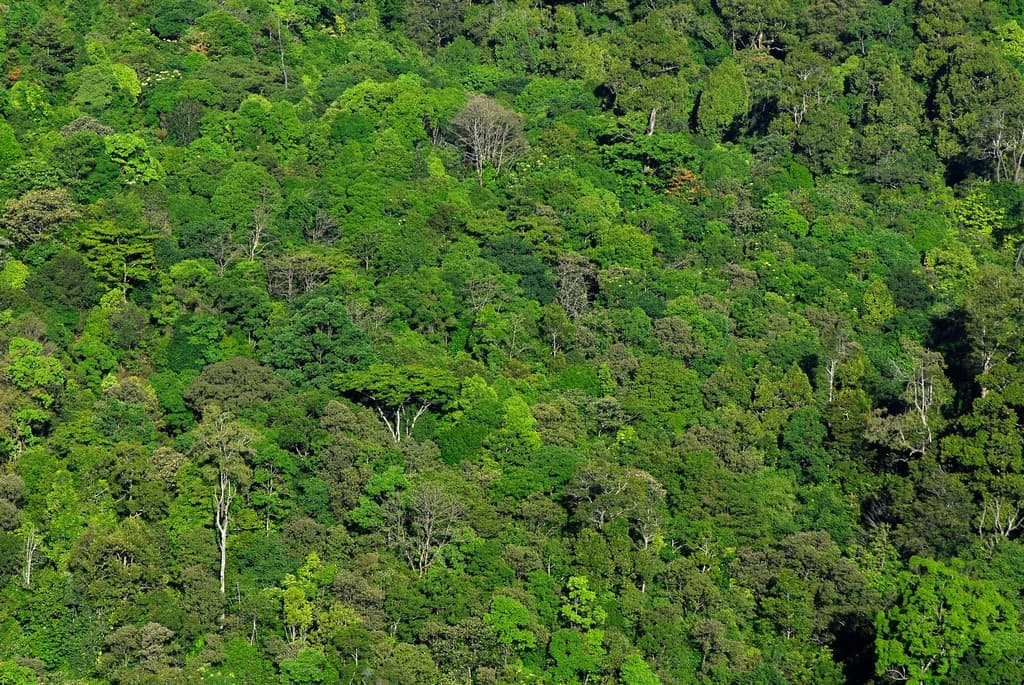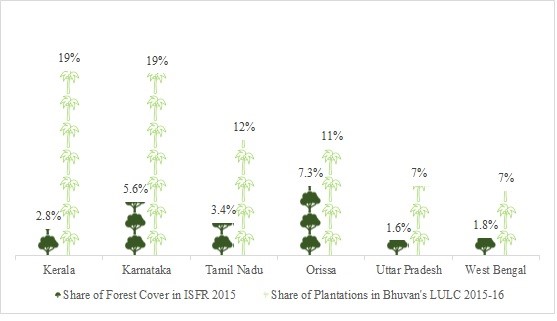An increase of 1,540 sq. km. of ‘forest cover’ in the recently published Indian State of Forest Report (ISFR) 2021 started the year on a ‘green’ note. This continues the trend of recent ISFRs that consistently manage to announce increased forest cover by cleverly tweaking the definition of forests. Thus, it is important to read the fine print more than the headline.

Photo: Dr. Anish Andheria
The ISFR uses a canopy cover metric to define a forest which enables the classification of plantations under the same category. This effectively nullifies the destruction of primary growth forest cover as long as it is converted to plantations. In other words, all commercial ventures, like rubber, banana, coconut, etc, plantations, are classified as a forest.
Touted as a wall-to-wall assessment of forest cover in the country, the ISFR report has become another green-washing tool in the face of environmental compromises of the government. Despite Global Forest Watch and other independent agencies consistently flagging the declining forest cover, ISFR continues to report ‘increases’ based on its convenient definitions.
The act of commission is accompanied by the omission of the government’s own Bhuvan dataset, which classifies plantations as a separate category, something that ISFR refuses to do. Why is this important?
As a mental exercise, picture a forest. Regardless of whether one has been to a forest or not, the imagination conjures up a vision of a vast variety of trees and a multitude of animal species. While the abundance of nature may differ across imaginations, ‘variety’ is the constant. This variety is the most basic differentiating factor between a plantation and a forest. A rubber plantation, for instance, has rubber trees alone (monoculture).
A plantation also implies human involvement to the extent of clearing mixed natural forests or finding land and literally planting the species of choice. This species of choice is inevitably driven by returns. They may be economical as in the case of rubber plantations or political as in the case of tree plantation drives.
Forests, on the other hand, have been around for thousands of years—the ones, which are fortunate enough to escape ravages of mankind. In naturally occurring forests, the variety of vegetation is spatially unique and a product of a complex process of succession. The ecosystem services derived from a forest are plenty and often unrecognised. Their maintenance locks the land underneath from being employed in a large-scale financial activity like mining. The financial opportunity cost of conserving a forest, therefore, is high.
Passing off plantations as forests may result in undetectable conversion of the latter to the former. The short-term economic incentives backing monoculture plantations may catalyse the clearing of highly bio-diverse natural forests and still wrongly contribute to an increase in ‘forest cover’. The leading states in this year’s ISFR, Andhra Pradesh and Telangana, have been largely credited for their increase in plantations.
This mandates a clear distinction between areas under the two ecosystems. Comparing ISFR statistics with a dataset which records plantations and forests separately may help drive the point home. ISRO (Indian Space Research Organisation) uses satellite imagery to capture geographical data, freely accessible on its Bhuvan platform. Every five years, it releases the land use land cover dataset, the latest being for 2015-16. This dataset records area under forests, delineating plantations.

(Kerala and Karnataka have 19% of the total area under plantations in the country.)
ISFR 2015 recorded Kerala and Karnataka as having about 3% and 6% of the country’s total forest cover. The Bhuvan dataset reveals that almost a fifth of their area under ‘forest cover’ was actually plantations. This proportion of plantations is different for each state. Thus, it would be interesting to observe the gainers and the losers once this proportion of ‘planted’ forest area is discounted for. What makes this a significant concern is the fiscal implication of this. The data presented in the ISFR directs national efforts to conserve forests. The 15th Finance Commission (FY2021-26) distributed 10% of the divisible tax revenues among states, based on their share in total forest cover, calling it the ‘forest and ecology’ criteria. This devolution, by itself, is a laudable reflection and recognition of the global environmental discourse.
Quoting the 13th Finance Commission when this criterion was elaborated upon: “The forest grant we recommend is essentially a reward for contributing to the ecology and biodiversity of India, as well as compensation to states for the opportunity loss on account of keeping areas under forest.”
This criterion was included to compensate for the financial opportunity cost of maintaining a forest, which is considered as a global public good. There is enough evidence to show that, like other production activities, plantations that don’t consider the local ecology can end up damaging it. Even those plantations that are aligned with local climatic conditions score poorly on the biodiversity front.
Thus, the existing devolution of the grant does not explore the full potential of such transfers, as envisioned by the 13th Finance Commission while instituting it. The 13th Finance Commission lamented the lack of data on biodiversity and incentivised its collection. While the biennial publication of the ISFR reports enables availability of latest data for the devolution, its assessment of forest cover is incorrect as argued above. A decade and a half later, when the data from government sources, like Bhuvan, is available in the public domain, it may be a good time to revisit some definitions and criteria.
About the authors: Gauri Atre is an Economics Researcher, and Aniket Bhatkhande leads Economics Research at Wildlife Conservation Trust and is a doctoral student at the Mumbai School of Economics and Public Policy.
This article was originally published on May 13, 2022, on Moneylife.in
Disclaimer: The authors are associated with Wildlife Conservation Trust. The views and opinions expressed in the article are their own and do not necessarily reflect the views and opinions of Wildlife Conservation Trust.
Your donations support our on-ground operations, helping us meet our conservation goals.
Related Links
- Our Story
- Rise in Wildlife Crime: Pandemic’s Intensifying Collateral Damage
- 2016 wins the race for – “The Hottest Year on Record”
- The Long-term Viability of Tigers in Protected Areas is Dependent on Corridors
- Our Publications
